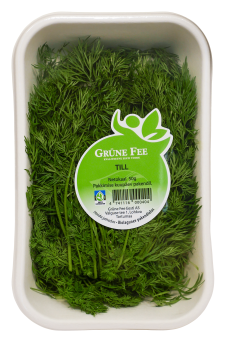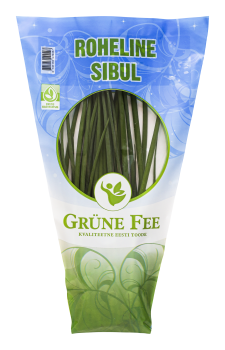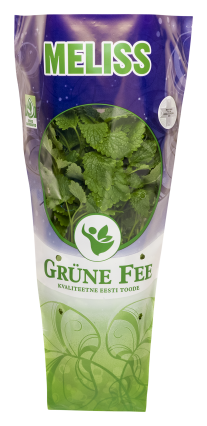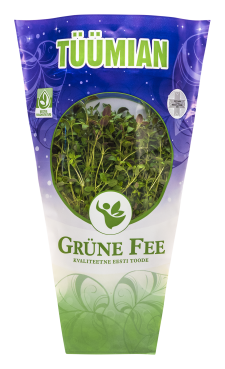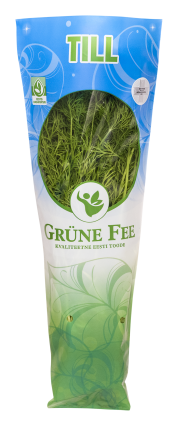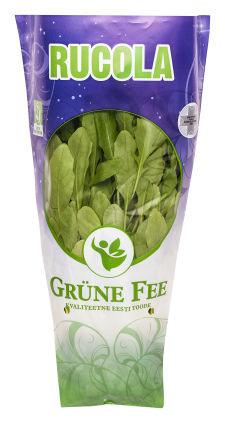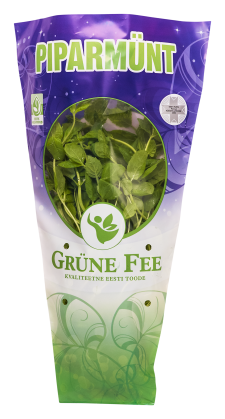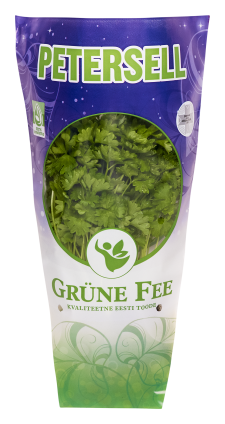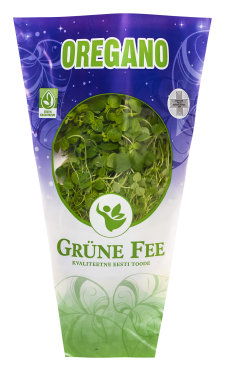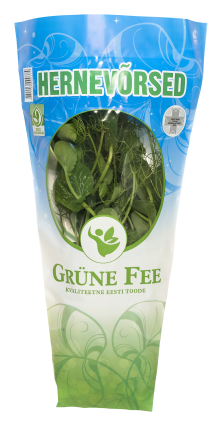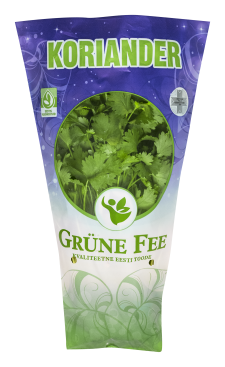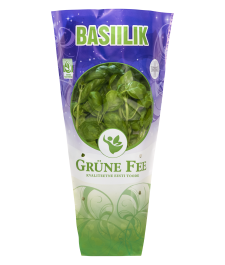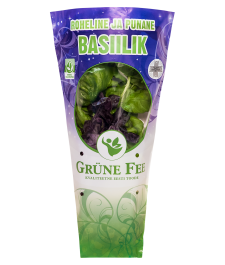Products

Freshly Cut Dill
Freshly Cut Dill
XNew Grüne Fee Product – Freshly Cut Dill!
Introducing a fresh addition to the Grüne Fee selection—freshly cut dill, conveniently packed on a biodegradable serving tray. No tough stems, no quality inconsistencies—just the best part of this flavorful herb!
Dill can be used fresh, dried, or frozen, making it a versatile ingredient for a variety of dishes. It pairs well with meat, fish, and vegetable-based meals, adds depth to soups, broths, and sauces, and is essential for pickling cucumbers as well as seasoning freshly boiled potatoes.
How to Store Dill?
Fresh dill lasts longest at +4 to +8°C, so the refrigerator is the best place to keep it fresh and flavorful.
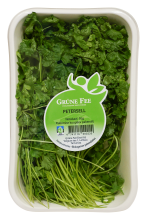
Freshly Cut Parsley
Freshly Cut Parsley
XNew Grüne Fee Product – Freshly Cut Parsley!
Introducing a new addition to the Grüne Fee selection—freshly cut parsley, conveniently packed on a biodegradable serving tray. No tough stems, no quality inconsistencies—just the best part of this flavorful herb!
Parsley is a highly valued herb, perfect for both fresh and dried use. It enhances soups, meat and fish dishes, vegetable-based meals, sauces, and salads. It’s also excellent for garnishing various dishes, ensuring every meal is unique and delicious.
How to Store Parsley?
The ideal storage temperature is +4 to +8°C, making the refrigerator the best place to keep it fresh.

Freshly Cut Dill & Green Onion
Freshly Cut Dill & Green Onion
XNew Grüne Fee Product – Freshly Cut Dill & Green Onion!
Introducing a new addition to the Grüne Fee selection—freshly cut dill and green onion, conveniently packed on a biodegradable serving tray. No tough stems, no quality inconsistencies—just the best part of these flavorful herbs!
A classic combination of fresh herbs makes every meal more enjoyable. Both dill and green onion can be used fresh, dried, or frozen in a wide variety of dishes for cooking and garnishing.
Dill is a versatile herb that enhances meat, fish, and vegetable dishes. It also works beautifully in soups, broths, and sauces. Essential for pickling cucumbers and perfect for seasoning freshly boiled potatoes.
Green onion tops can be used in many ways to add freshness and flavor to dishes—they truly are kitchen superheroes!
- Salads – Chopped green onions give salads a delightful crunch and fresh taste.
- Soups and broths – Add them at the end of cooking to preserve their freshness.
- Egg dishes – A great addition to omelets or scrambled eggs.
- Grilled or fried dishes – Pairs well with meat, fish, and vegetables.
- Sauces and dips – Mixed with sour cream or yogurt to create a delicious sauce.
- Dough and pies – Adds a special nuance to baked goods.
- Sandwiches – A great topping for sandwiches.
For a tasty side salad, fresh green onion stems can be mixed with tomatoes, cucumbers, and sour cream. While best eaten fresh, they also work well when dried.
How to Store Fresh Dill and Green Onion?
Both fresh dill and green onion last the longest at a temperature of +4 to +8°C. The easiest way to preserve their freshness is by storing them in the refrigerator.
This keeps them crisp and flavorful for a longer period!
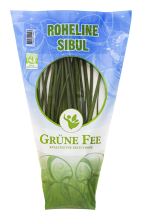
Green onion
Green onion
XGreen Onion – A True Kitchen Hero!
Green onion tops can be used in many ways to add freshness and flavor to dishes—they truly are kitchen superheroes!
- Salads – Chopped green onions give salads a delightful crunch and fresh taste.
- Soups and broths – Add them at the end of cooking to preserve their freshness.
- Egg dishes – A great addition to omelets or scrambled eggs.
- Grilled or fried dishes – Pairs well with meat, fish, and vegetables.
- Sauces and dips – Mixed with sour cream or yogurt to create a delicious sauce.
- Dough and pies – Adds a special nuance to baked goods.
- Sandwiches – A great topping for sandwiches.
For a tasty side salad, fresh green onion stems can be mixed with tomatoes, cucumbers, and sour cream. While best eaten fresh, they also work well when dried.
How to store green onions?
Fresh green onions last longest at temperatures between +4…+8°C. That’s why storing them in a cool place, such as a pantry or refrigerator, is ideal. For longer storage, they need light watering daily. They can be kept in a glass of water with the pot but should remain in a cool space. They can also stay fresh on a kitchen counter or windowsill if watered properly, but warm conditions shorten their lifespan.
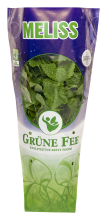
Lemon balm
Lemon balm
XLemon balm has a lemony scent and flavour, and it is used in cooking, herbal medicine, and honey production. The herb is used for making medicinal tea, while fresh and dried leaves are used for cooking. Lemon balm leaves and shoots should be used before flowering, as once the plant starts to flower, it develops a bitter taste.
As a flavouring, lemon balm is used in all kinds of dishes that go well with lemon due to its similar taste and aroma. It can also be used successfully with other herbs, though lemon balm should only be added after boiling. The somewhat hairy leaves, when used in moderation, can be used to wonderful effect in salads. This goes particularly for raw food salads containing apples, pumpkin, zucchini or carrots. Lemon balm is also used in soups, sauces, pea and carrot foods, cold green sauces, boiled fish, and egg dishes, and is one of few herbs used for flavouring compotes, juices, jellies, and sweet vegetable preserves. Fresh lemon balm leaves are used for garnishing desserts and cold dishes. Also used in the canning industry, and widely in the liqueur and vodka industries. Lemon balm is a great substitute for lemon, which makes it perfect for preparing stuffed fish. It can used to make vinegar as well as infused oils.
Lemon balm makes a wonderfully refreshing tea on hot days, and hot lemon balm tea goes well with any meal or dessert as an alternative to coffee.
To prepare a refreshing tea, try combining lemon balm with sweet wine and black tea. Prepare the black tea and lemon balm tea infusion separately, as black tea requires boiling water and 3 minutes of steeping, while lemon balm should be steeped in hot water for 10 minutes. After cooling, mix with wine and keep in the refrigerator or serve with ice. For extra flavour, try adding some tarragon. Lemon balm can also be used to prepare a tasty buttermilk drink by mixing chopped lemon balm leaves with dairy ice cream in a blender.
To prepare lemon balm tea, it is generally recommended to use 1 tablespoon of the dried herb for 1 cup of hot (not boiling!) water. Then steep for 10 minutes and drink while hot.
Storage tips
Lemon balm is best stored between +4 and +8 °C. This means storage is easiest in a cool place, such as a pantry or refrigerator. For longer storage, you should also lightly water the plant once a day. You can keep the pot in a glass of water, but cool conditions are still recommended. Will also keep on the kitchen table or a window sill if watered properly, though not quite as long as when kept cool. Lovely to look at and fills the air with a wonderful aroma when kept on a table.
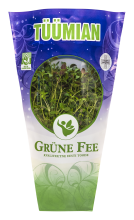
Thyme
Thyme
XThyme is an extremely fragrant plant rich in essential oils. It is mainly added to foods in dried form, but can also be used fresh. Suitable for use in all kinds of soups, pastas, stews, and sauces, as well as vegetable and egg dishes. Excellent for adding flavour to meat marinades and fish.
Storage tips
Thyme is best stored between +4 and +8 °C. This means storage is easiest in a cool place, such as a pantry or refrigerator. For longer storage, you should also lightly water the plant once a day. You can keep the pot in a glass of water, but cool conditions are still recommended. Will also keep on the kitchen table if watered properly, though not quite as long as when kept cool.

Dill
Dill
XUsed fresh, dried as well as frozen. Dill is a versatile herb suitable for a variety of meat, fish and vegetable dishes. Tastes great in soups, broths and sauces. Indispensable for marinating cucumbers and seasoning boiled fresh potatoes.
Storage tips
Fresh dill lasts longest when kept between +4 and +8 °C. This means storage is easiest in a cool place, such as a pantry or refrigerator. For longer storage, you should also lightly water the plant once a day. You can keep the pot in a glass of water, but cool conditions are still recommended. Will also keep on the kitchen table or a window sill if watered properly, though not quite as long as when kept cool.
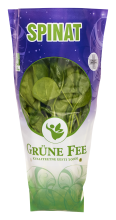
Spinach
Spinach
XSpinach can be used in both hot and cold dishes. It is a versatile plant that can really unleash your culinary imagination. For example, recently spinach has become a popular ingredient in smoothies. Spinach is used in soups, purées, fish, omelettes, pies, fresh salads, and even pancakes.
Storage tips
Fresh spinach lasts longest when kept between +4 and +8 °C. This means storage is easiest in a cool place, such as a pantry or refrigerator. For longer storage, you should also lightly water the plant once a day. You can keep the pot in a glass of water, but cool conditions are still recommended. Will also keep on the kitchen table or a window sill if watered properly, though not quite as long as when kept cool.
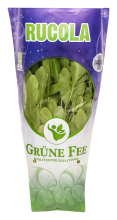
Garden rocket
Garden rocket
XThe slightly bitter and mustard-like flavour of this leafy herb makes it perfect for use in fresh salads, e.g. when combined with mild-flavoured leaf lettuce and feta or mozzarella. Excellent addition to pizzas, omelettes or steaks, as well as for making pesto. Young leaves have a flavour reminiscent of garden cress, mustard, and nuts.
Storage tips
It is best stored between +4 and +8 °C. This means rocket is easiest to store in a cool temperature-controlled space, such as a pantry or a refrigerator. For longer storage, you should also lightly water the plant once a day. You can keep the pot in a glass of water, but cool conditions are still recommended. Warmth leads to faster decay.
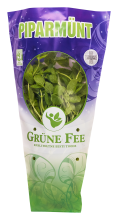
Peppermint
Peppermint
XThe peppermint plant is commonly used for making aromatic peppermint tea. Fresh peppermint leaves are also used for flavouring and garnishing a range of desserts. Can be used equally well for seasoning meat dishes.
Storage tips
Peppermint is slightly easier to preserve than most other herbs, as long as you protect it from the cold and water it well. While not as delicate as basil, peppermint leaves will turn dark in cool conditions. To keep it fresh longer, ensure an even temperature: temperature fluctuations reduce the shelf life of the plant. The most convenient way to store peppermint is to place it on the kitchen table in a decorative pot. This way, it is lovely to look at and will freshen the air with its wonderful aroma. Provided the plant is kept sufficiently moist, it will keep this way for a relatively long time.

Parsley
Parsley
XParsley is a popular herb with a high vitamin C content. Suitable both fresh and dried. Add to soups, meat, fish, vegetable dishes, sauces or salads. Perfect for garnishing a variety of dishes. Parsley promotes healthy digestion.
Storage tips
It is best stored between +4 and +8 °C, for example, in a pantry or refrigerator. For longer storage, you should also lightly water the plant once a day. You can keep the pot in a glass of water, but cool conditions are still recommended. Warmth leads to faster decay.
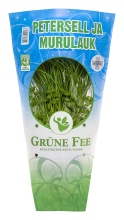
Parsley and chives
Parsley and chives
XA great mix of two highly valued herbs. Add this herb mix to salads or soups or use for garnishing a range of dishes.
Chives are commonly used for adding flavour to salads and soups. Also suitable on sandwiches. Milder than scallions. For a simple and tasty side salad, combine fresh chives with tomatoes, cucumber, and sour cream. Chives are best when fresh, but also great when dried.
Parsley is a popular herb, suitable both fresh and dried. Add to soups, meat, fish, vegetable dishes, sauces or salads. Perfect for garnishing a variety of dishes. Parsley promotes healthy digestion.
Storage tips
It is best stored between +4 and +8 °C. This makes potted plants easiest to store in a cool temperature-controlled space, such as a pantry or a refrigerator. For longer storage, lightly water the plant once a day. You can keep the pot in a glass of water, but cool conditions are still recommended. Warmth leads to faster decay.
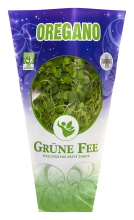
Oregano
Oregano
XOregano gives foods a pleasant aroma and spicy flavour. Fresh leaves are used for cooking, but many dishes can also be flavoured using dried oregano. Oregano goes best with meat, but also tastes great on pizzas and in soups. Oregano is an essential ingredient in any proper blood sausage and is known as ‘sausage grass’ by Estonians when used for this purpose. It is also suitable for making tea.
Storage tips
Oregano is best stored between +4 and +8 °C. This means storage is easiest in a cool place, such as a pantry or refrigerator. For longer storage, you should also lightly water the plant once a day. You can keep the pot in a glass of water, but cool conditions are still recommended. Will also keep on the kitchen table if watered properly, though not quite as long as when kept cool.

Chives
Chives
XChives are commonly used for adding flavour to salads and soups. Also suitable on sandwiches. Milder than scallions. For a simple and tasty side salad, combine fresh chives with tomatoes, cucumber, and sour cream. Chives are best when fresh, but also great when dried.
Storage tips
Fresh chives last longest when kept between +4 and +8 °C. This means storage is easiest in a cool place, such as a pantry or refrigerator. For longer storage, you should also lightly water the plant once a day. You can keep the pot in a glass of water, but cool conditions are still recommended. Will also keep well on the kitchen table or a window sill if watered properly, though not quite as long as when kept cool.
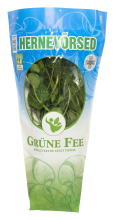
Pea shoots
Pea shoots
XA trendy leafy vegetable. Fresh pea shoots can be eaten on their own, added to salads, used for garnishing sandwiches and other foods, or mixed into hot dishes, such as stir-fries. Also great for serving on the side with potatoes, risottos or soups. Cooked pea shoots are a delicious addition to fish, chicken or pastas, while chopped shoots can be added to marinades and a range of sauces. Young shoots are the tastiest and mildest.
Storage tips
Pea shoots are best stored between +4 and +8 °C. This means they are easiest to store in a cool space, such as a pantry or refrigerator. For longer storage, you should also lightly water the plant once a day. You can keep the pot in a glass of water, but cool conditions are still recommended. Will also keep on the kitchen table or a window sill if watered properly, though not quite as long as when kept cool. As pea shoots are a delicious snack even on their own, don’t leave them out for too long or you might come back to an empty bowl.
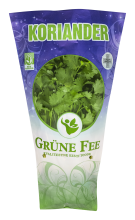
Coriander
Coriander
XFresh chopped coriander (or cilantro) leaves can be added to soups, sauces, poultry or lamb dishes, and, of course, fresh salads. Fresh coriander is used similarly to parsley, but take care not to use too much, as coriander has a significantly stronger flavour.
Storage tips
Potted coriander lasts longest when kept between +4 and +8 °C. This means storage is easiest in a cool place, such as a pantry or refrigerator. For longer storage, you should also lightly water the plant once a day. You can keep the pot in a glass of water, but cool conditions are still recommended. Will also keep on the kitchen table or a window sill if watered properly, though not quite as long as when kept cool.

Basil
Basil
XBasil is best used for making pesto sauce. It goes perfectly with cheese, tomatoes, and garlic, for example in wonderfully delicious tomato and basil bruschetta. Basil is a versatile herb that can be used both fresh and dried in meat, fish, cheese or pastas. It is equally great in oven-baked dishes, pasta sauces, and a variety of salads. Also used for making flavoured oils. Note! When making hot meals, add fresh basil at the end, after cooking or boiling.
Storage tips
Basil should be stored in a relatively warm place. Ideal temperature is around 14 °C. For a longer shelf life, remember to water the plant. Avoid keeping basil in the refrigerator: temperatures below 10 °C will damage the leaves and cause them to turn black relatively quickly. You should also avoid crushing or squeezing the plant, e.g., when packed between other items in a shopping bag. This will cause the leaves to go brown and any snapped edges to quickly turn black. In the winter, place your store-bought basil plant in a separate bag or wrap it in paper to prevent cold damage during transport. And remember to take it out of the car once you get home, as sub-zero degrees will cause the plant to die. The most convenient way to store basil is to place it on the kitchen table in a decorative pot. This way, it is lovely to look at and will freshen the air with its wonderful aroma. Provided the plant is kept sufficiently moist, it will keep this way for a relatively long time.

Green and red basil
Green and red basil
XThis mix of green and red basil is perfect for vegetable lovers who consider appearances at least as important as taste – the differently coloured leaves create attractive contrast when used for garnishing or in salads.
Basil is best used for making pesto sauce. It goes perfectly with cheese, tomatoes, and garlic, for example in wonderfully delicious tomato and basil bruschetta. Basil is a versatile herb that can be used both fresh and dried in meat, fish, cheese or pastas. It is equally great in oven-baked dishes, pasta sauces, and a variety of salads. Also used for making flavoured oils. Note! When making hot meals, add fresh basil at the end, after cooking or boiling.
Storage tips
Basil should be stored in a relatively warm place. Ideal temperature is around 14 °C. For a longer shelf life, remember to water the plant. Avoid keeping basil in the refrigerator: temperatures below 10 °C will damage the leaves and cause them to turn black relatively quickly. You should also avoid crushing or squeezing the plant, e.g., when packed between other items in a shopping bag. This will cause the leaves to go brown and any snapped edges to quickly turn black. In the winter, place your store-bought basil plant in a separate bag or wrap it in paper to prevent cold damage during transport. And remember to take it out of the car once you get home, as sub-zero degrees will cause the plant to die. The most convenient way to store basil is to place it on the kitchen table in a decorative pot. This way, it is lovely to look at and will freshen the air with its wonderful aroma. Provided the plant is kept sufficiently moist, it will keep this way for a relatively long time.
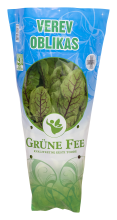
Red-veined sorrel
Red-veined sorrel
XThe red-veined sorrel, identifiable by its attractive leaves which are criss-crossed by reddish veins, is significantly milder than the common sorrel. Mostly used in fresh salads, but also suitable for stir-fries, pies and a variety of egg dishes.
Storage tips
It is best stored between +4 and +8 °C. This means storage is easiest in a cool temperature-controlled space, such as a pantry or a refrigerator. For longer storage, you should also lightly water the plant once a day. You can keep the pot in a glass of water, but cool conditions are still recommended. Warmth leads to faster decay.
